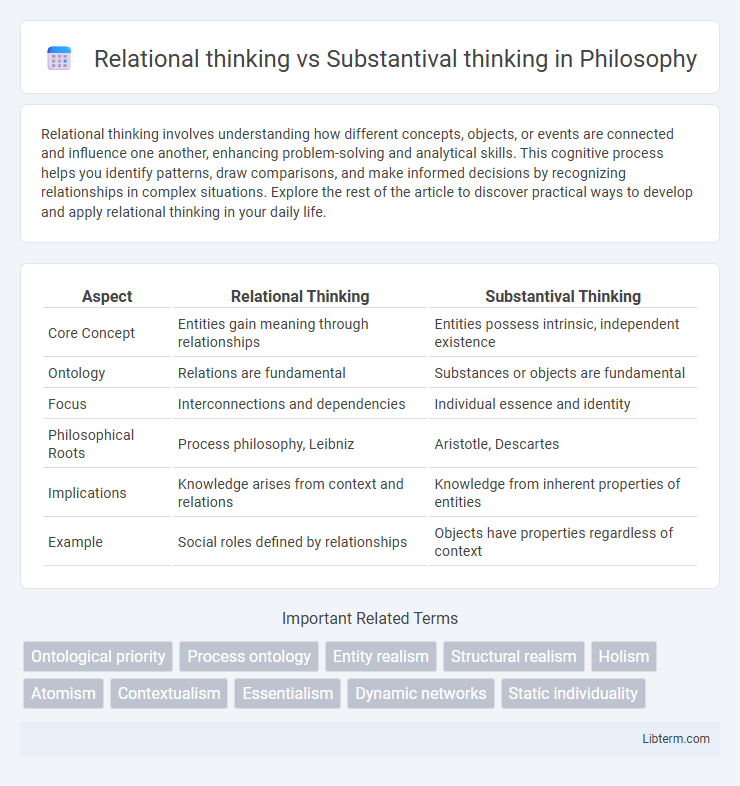Relational thinking involves understanding how different concepts, objects, or events are connected and influence one another, enhancing problem-solving and analytical skills. This cognitive process helps you identify patterns, draw comparisons, and make informed decisions by recognizing relationships in complex situations. Explore the rest of the article to discover practical ways to develop and apply relational thinking in your daily life.
Table of Comparison
| Aspect | Relational Thinking | Substantival Thinking |
|---|---|---|
| Core Concept | Entities gain meaning through relationships | Entities possess intrinsic, independent existence |
| Ontology | Relations are fundamental | Substances or objects are fundamental |
| Focus | Interconnections and dependencies | Individual essence and identity |
| Philosophical Roots | Process philosophy, Leibniz | Aristotle, Descartes |
| Implications | Knowledge arises from context and relations | Knowledge from inherent properties of entities |
| Example | Social roles defined by relationships | Objects have properties regardless of context |
Introduction to Relational and Substantival Thinking
Relational thinking emphasizes the importance of relationships and interactions among entities, whereas substantival thinking focuses on entities as independent, self-contained units. This distinction is foundational in fields such as physics and philosophy, where understanding whether space, time, or objects exist independently or in relation to one another impacts theoretical frameworks. Exploring these perspectives clarifies debates around objectivity, continuity, and the nature of reality.
Defining Relational Thinking
Relational thinking emphasizes understanding objects, concepts, or phenomena through their relationships and interactions rather than as isolated entities. This cognitive approach prioritizes context, connections, and dynamic interplay, revealing how meaning emerges from systems and networks. Defining relational thinking involves recognizing that significance is derived from interdependencies, contrasting with substantival thinking, which treats entities as independent and self-contained.
Defining Substantival Thinking
Substantival thinking defines objects as independent entities that exist with intrinsic properties apart from their relationships. This approach treats objects as self-contained units whose identity and characteristics are unaffected by external contexts. Substantival thinking contrasts with relational thinking, which emphasizes the interconnectedness and mutual dependence of objects within a system.
Historical Background and Philosophical Roots
Relational thinking, rooted in the philosophy of figures like Leibniz and modern process philosophers, emphasizes the interconnectedness and dependency of entities within a network of relations, challenging the substantivalist view that treats objects as independent and self-contained substances. Substantival thinking traces back to Newtonian physics and Cartesian metaphysics, positing space and time as absolute entities existing independently of objects and highlighting the autonomy of substances. The historical debate between these paradigms reflects foundational questions in metaphysics regarding the nature of existence, causality, and the structure of reality.
Key Differences Between Relational and Substantival Approaches
Relational thinking emphasizes the significance of relationships and interactions between entities as fundamental to understanding reality, whereas substantival thinking treats entities as independent, self-sustained objects existing in space and time. The key difference lies in ontology: relational approaches consider space, time, and objects as interdependent, while substantival views hold them as absolute and separable. This contrast influences perspectives in physics, philosophy, and cognitive science regarding the nature of existence, identity, and causality.
Applications in Science and Philosophy
Relational thinking emphasizes the importance of relationships and interactions between entities, forming the basis for theories in quantum physics and systems biology where context and connections shape behavior. Substantival thinking treats entities as independent and self-contained, aligning with classical mechanics and certain metaphysical frameworks that prioritize intrinsic properties over external relations. In philosophy, relational thinking underpins process philosophy and relational ontology, while substantivalism supports substance metaphysics and traditional notions of object identity.
Advantages of Relational Thinking
Relational thinking enhances cognitive flexibility by emphasizing the connections and contexts among entities rather than viewing them as isolated, enabling more comprehensive problem-solving and decision-making. This approach promotes deeper understanding in scientific, social, and philosophical analyses by focusing on the interactions and relationships that define phenomena. Emphasizing relational structures supports innovation and adaptability, crucial for addressing complex, dynamic systems in various disciplines.
Strengths of Substantival Thinking
Substantival thinking excels in providing clear, absolute frameworks for understanding objects and their properties independently of external relationships. It allows for precise analysis of entities as fundamentally distinct and self-contained, facilitating straightforward problem-solving in fields like classical physics and formal logic. This approach supports consistent categorization and the application of invariant properties, enhancing stability and predictability in theoretical models.
Relational vs Substantival Thinking in Modern Contexts
Relational thinking emphasizes the interconnectedness of entities, viewing objects and concepts as defined primarily by their relationships, which aligns closely with contemporary approaches in physics and social sciences that prioritize systems and networks. Substantival thinking treats entities as independent and self-contained, reflecting classical views that often underpin legal and ontological frameworks focusing on individual identity and intrinsic properties. In modern contexts, relational thinking drives advances in understanding complex systems, such as in quantum mechanics and relational databases, while substantival perspectives remain essential for issues of object permanence and property rights.
Choosing the Right Approach: Practical Considerations
Relational thinking prioritizes understanding entities through their relationships and interactions, making it ideal for complex social, organizational, or ecological analyses where context and dynamics matter. Substantival thinking emphasizes independent, self-contained entities, providing clarity and precision in fields like classical physics or formal logic where isolation of variables is crucial. Choosing the right approach depends on the problem's nature, with relational thinking suited for interconnected systems and substantival thinking for discrete, well-defined units.
Relational thinking Infographic

 libterm.com
libterm.com